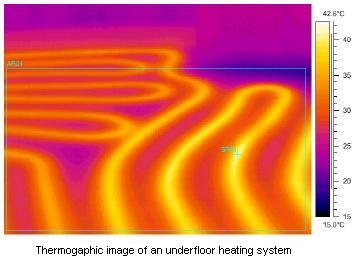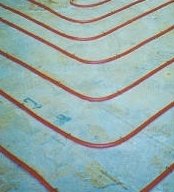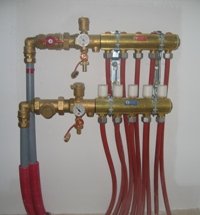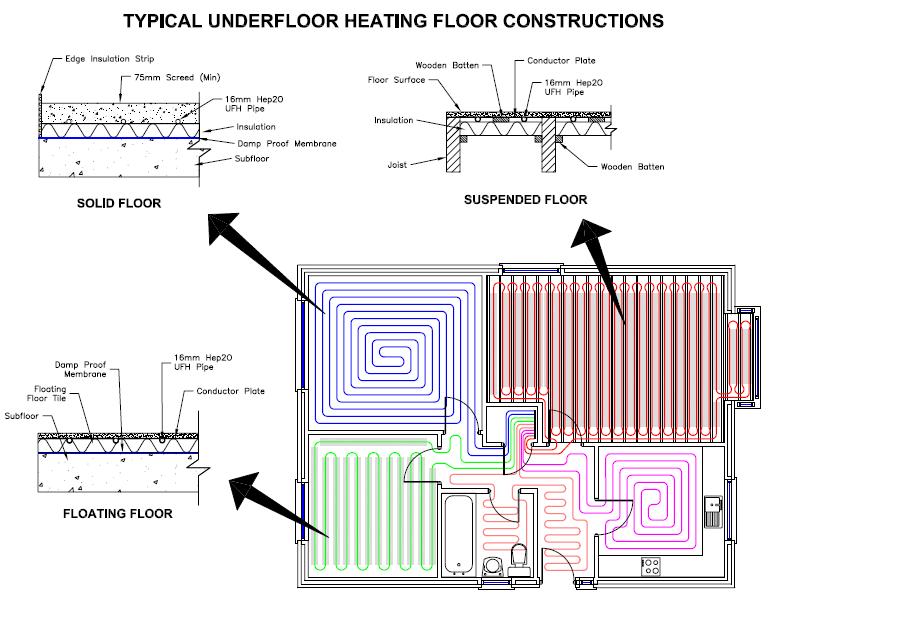Underfloor Heating - Why It's So Good
This page contains sections on:
What is Underfloor Heating (UFH)?
The basic principle of UFH is that heated water is circulated through pipes, these are usually plastic or a plastic and metal composite (earlier installations used copper pipes), that are buried in the floor structure. UFH warms the floor which then warms the room space.
(Click image above - opens in new window)
The main transfer of heat is by radiation - about 60% radiation and the other 40% by weak convection currents. Because warm air naturally rises, UFH is very effective in creating a comfortable environment at lower room temperatures compared with other types of space heating systems.
Underfloor heating is also referred to as:
- Undertile heating
- Radiant tube heating
- Radiant heating
- In-Floor heating
How Hot Will The Floor Get?
Because the floor is being used as the radiator which is much larger than say a standard wall hung steel panel hot water radiator, the actual temperature is quite low.
The surface temperature of an UFH system will be about 29°C or below in all occupied ares so that an acceptable degree of room comfort is achieved (this is generally about the temperature of your palm).
Sometimes lower temperatures, such as 27°C, are required for timber floors and certain flooring like laminate (you don't want to undermine the performance of the floor adhesive - the glue).
Remember it is essential to take particular care that floor coverings (underlay with fitted carpets) do not provide too great a degree of insulation therefore preventing the heat from the UFH to raise the room temperature.
Choose a carpet with a Tog value of less than 1.5 (Tog is the thermal resistance of a textile, the higher the value the higher the resistance).

Where Can it Be Installed?
Underfloor heating can be installed in:
- Screed or Solid Floor
- Timber Floor
- Suspended Floor
- Floating Floor
- Walls
 UFH Coils
UFH CoilsIn the Screed or solid floor the UFH relies on the conductivity of the screed or concrete to conduct the heat from the pipes to the underside of the floor finish.
(image of Solid Floor installation above)
Timber floors can have a sand and cement mix to conduct the heat to the floor, or pre-formed panels with or without aluminium/aluminum heat transfer plates to conduct the heat from pipe to floor.
Suspended floors same as timber floor.
Floating floor installations are generally achieved by laying a pre-formed high-density polystyrene panel on top of the prepared floor base, either an existing flooring system or a new construction. The pipework is laid into the pre-formed profile, with or without aluminium/aluminum heat transfer plates.
The floor decking is usually chipboard or finished timber or laminate which is laid on top of the installation. Although the decking sections are glued together they are not fixed to the installation but left to 'float' on top of it. If you want to use carpet you can lay it onto the chipboard decking.
Walls use gypsum pre-formed panels.
(Click on the thumbnails above to enlarge - opens in new window)
The rate of heat output from an underfloor heating system is determined by the:
- Mean Water temperature
- Spacing and diameter of pipework
- Floor finish
- Floor construction
System Components
The major components of an underfloor heating system are:
- The heat source
- Circulating pump
- Heat distribution to the manifold (pipe circuit)
- Flow and return manifolds
- Underfloor heating circuit pipework
- Insulation
 UFH Manifolds
UFH Manifolds(The Flow and Return Manifolds)
What Are The Advantages?
The benefits of an underfloor heating system are;
- A Healthy Environment - Underfloor-heating produces no chemicals, dust particles, odours or fumes, making it more appropriate for asthmatics, people with allergies and other chemical sensitivities.
The lower temperature required for UFH systems helps to maintain a natural humidity and a low static electricity level, which is beneficial for arthritis sufferers. - Radiant Heat is Clean - Household fabrics and painted surfaces stay brighter and much fresher because radiant heat carries no grimy fumes, no particles of dust.
- No Sound pollution - UFH systems are quiet unlike forced air and you are not subjected to unpleasant drafts as with ducted air systems.
- Energy Savings - Because UFH systems operate at lower temperatures you make saving straight away in fuel costs around 10 - 15%.
If you used a condensing boiler or even better a thermal energy heating system (ground source heat pump) or a hydronic heating cooling system (water source heat pump) as your heat generator you will benefit in increased efficiency and savings of 30 - 40% can be achieved as UFH systems are designed to operate with lower flow and return water temperatures that can be provided by these systems. Underfloor heating can also be pre-heated via solar heating once again utilizing a renewable energy source.
What Are The Disadvantages?
Underfloor heating has a slower response time in both heating up and cooling down than other heater types; timber floors respond better than screed or concrete floors. Therefore, UFH is not an efficient heating system if used infrequently.
Note: even though timber floors responds better - heats up quicker than screed or solid floors, timber floors and timber suspended floors do not conduct heat as efficiently as screed or concrete floors - this basically means there is less heat output from timber floors.
To get timber floors to give out more heat and act as a screed floor then the air gap between the insulation and floor should be filled with a lightweight screed mix a ratio of 10:1 sand/cement with enough water to hold the mix together. This would generally be about 25mm thick with the pipe included in it with an approximate weight of 18kg/m2.
Underfloor heating systems are designed to operate at a constant temperature level during the day, and at a 'setback' (lower) temperature about 3°C lower at nights (or when unoccupied) - when operated in this way, there is no disadvantage to underfloor heating.
See also:
- DIY Heating Plumbing Tips 1
Underfloor Heating Design And Installation Guide - Solar Heating
- Hot Water Radiators
- Hydronic Heating System Expansion Tank
 |
Click here to visit online store.
Home Heat Loss Heat Gain Radiant Heat Central Heating Radiators UFH
Heat Pumps GSHP's WSHP's ASHP's Solar Heating PV Systems Boilers
Water Heaters Insulation Elec-Heaters
Terms of Use | Privacy | Contact Us

|
Visitors Say
Hi, My name is Shannon and I'm one of home-heating-systems-and-solutions.com readers. I'd like to thank you for the excellent information I've found on home-heating-systems-and-solutions.com, it's one of my favorite readings on the net. Warmest Regards Shannon United States
Thanks for the advice for removing an air lock from an indirect system. Had to change an inlet on my cistern. First time I have tried any home plumbing. After draining the cold tank system air locked when I refilled the tank. Garden hose and mains pressure up the tap sorted my problems. Would not have known what to do without the advice on the site. Many thanks Sean United Kingdom.
An excellent site. I have found it very usefull. I am currently in the design phase of a new house and have be pondering which heat system to use. From your site I have been able to choose the right system. Ross New Zealand
I enjoyed your site. Pat United States
We're so excited to announce our first Children Book
The Special and Talented Dog Show
To order click here
The second book published is called
Flying Things
This is aimed at a pre-school audience and is a rhyming story. You can buy by clicking here
To read more about our children's books, click here









